October 26, 2025 – Day 5 of Women’s INEB, Dubuk Jungto Retreat Center
Hello. Morning has dawned at Dubuk Jungto Retreat Center. Today is the fifth day of the Women’s INEB Jungto Society Study Tour.
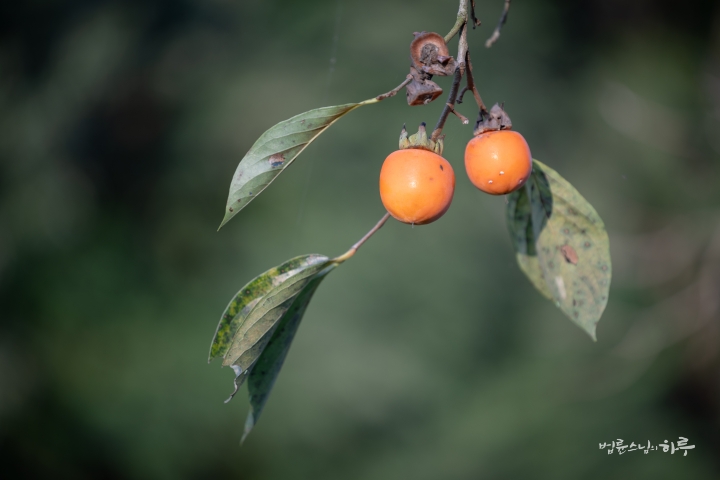
After completing morning practice and meditation, Sunim attended the Women’s INEB Jungto Society Study Tour program starting at 9 AM. The morning session featured a detailed introduction to ‘Jungto Society’s Social Action Activities.’
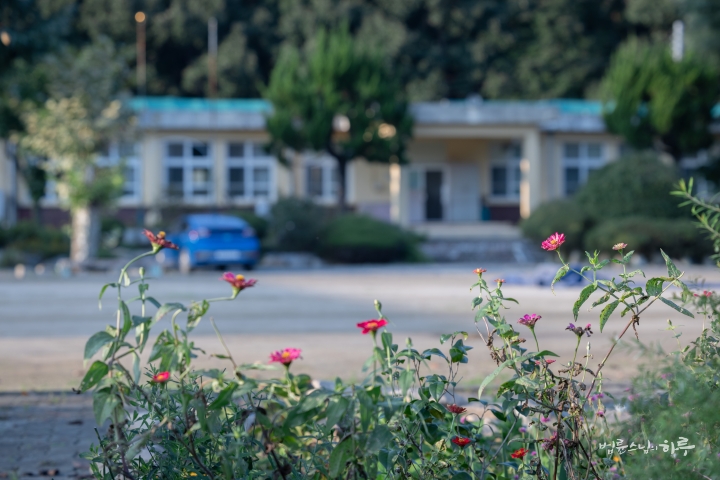
First, Ms. Choi Jeong-yeon from the International Cooperation Team introduced the activities of JTS, Eco Buddha, Good Friends, and The Peace Foundation, and answered questions about these organizations.
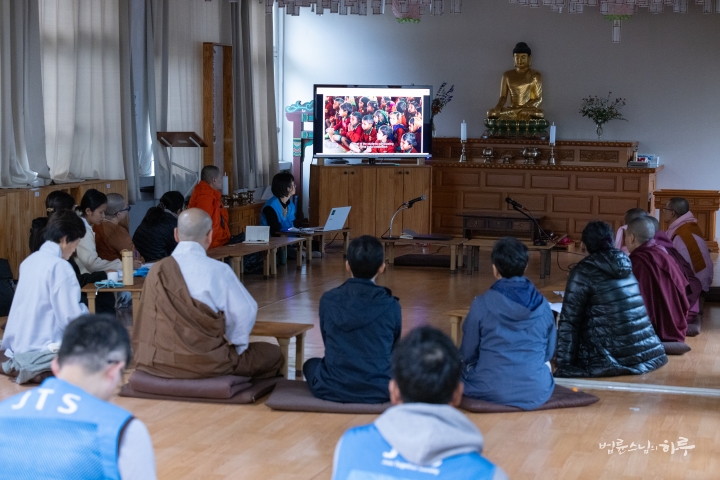
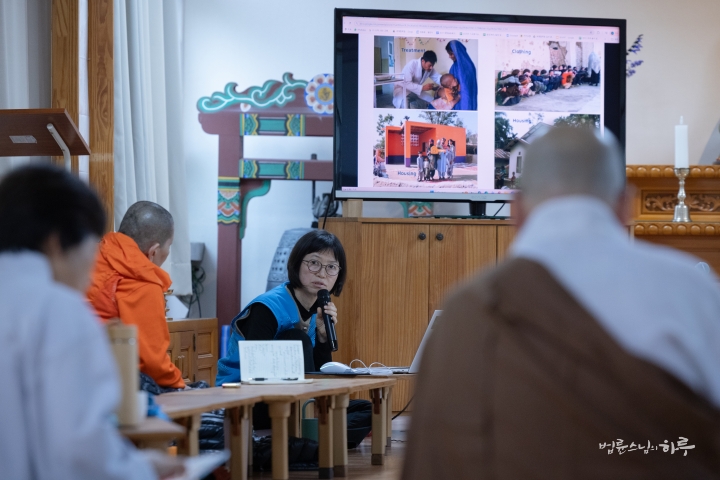
Also present were Dharma Teacher Seonju, who pioneered JTS India’s early projects, Dharma Teacher Bogwang, Director of JTS India who was visiting Korea to attend the JTS 32nd Anniversary Seminar, and Dharma Teacher Hyanghoon, Director of JTS Philippines. When participants asked questions about JTS projects, the three Dharma Teachers provided direct answers. Sunim sat in the back row, listening attentively to the conversation.
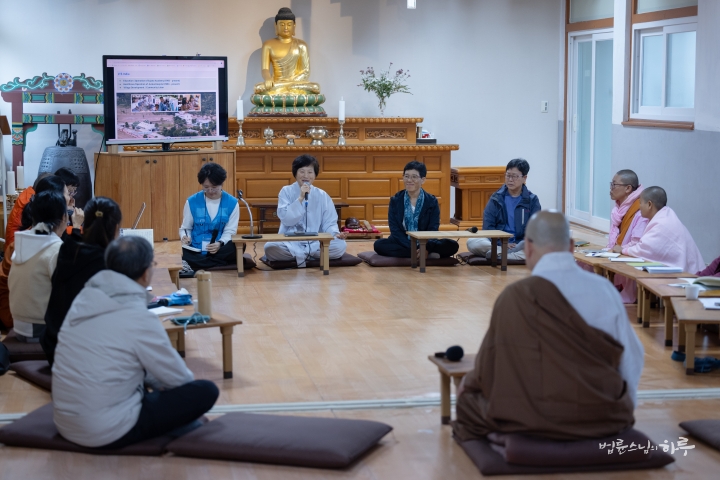
When JTS pioneers projects in poor countries, do you set a specific timeframe? Do you have plans to hand over the projects to local people?
I wonder if the residents can become self-sufficient when JTS withdraws.
In conflict areas like Mindanao, there must have been many difficulties when pioneering projects. Where does the strength to overcome these difficulties come from?
I’m curious about how you personally came to meet Jungto Society and became a Dharma Teacher.
While doing Jungto Society activities, people can get old or sick. Is there a system and space in place to care for such people?
What plans does Jungto Society have to ensure that the principles it has established can be passed on to the next generation?
Although my body isn’t what it used to be as I’ve aged, my passion remains the same. In this situation, how can the elderly continue to participate meaningfully amid social changes?
Does JTS have plans to work in countries other than India and the Philippines?
When the Dharma Teachers found certain questions difficult to answer, Sunim continued with the responses. As the conversation deepened, various questions continued to arise.
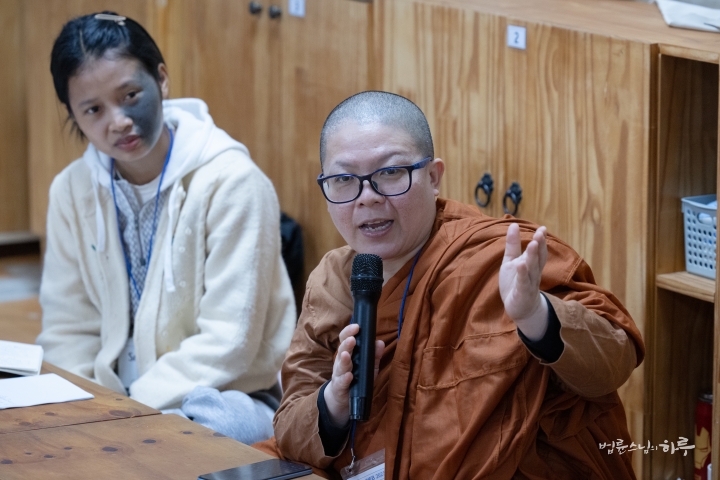
“In India, you’ve continued support for over 30 years, waiting until the residents become self-sufficient. Do you plan to continue the same long-term support in other countries for 40, 50, or even 60 years until the residents can stand on their own?”
Sunim answered this question.
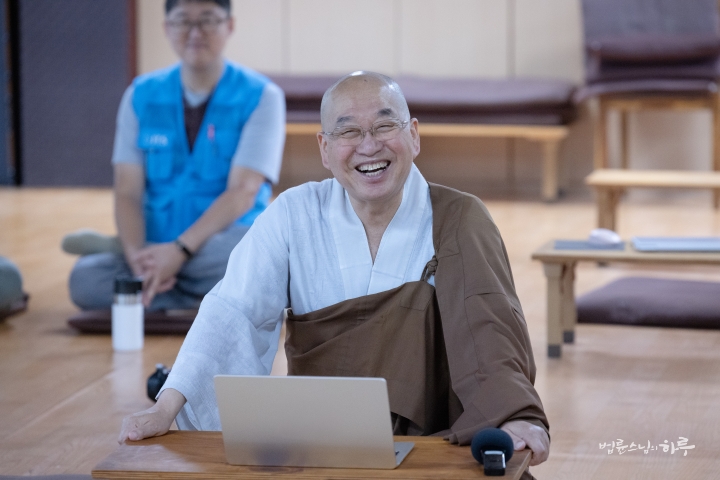
“In India’s case, since we directly established schools and educated children, the project naturally had to continue long-term. However, we have almost no plans to proceed with projects in this manner going forward. Now, local people handle the necessary education themselves, and we only play a role in building schools or supporting facilities. Therefore, I don’t think long-term plans are particularly necessary.
However, despite being emergency relief work, the Pakistan case has continued for several years. This is because the local partner NGO has been conducting the project very diligently. In such cases, support can naturally continue. In Pakistan, we’ve conducted emergency relief seven times so far, and have provided about 2,200 hand pumps. We’ve also built about 200 small houses.
However, finding such trustworthy organizations isn’t easy. Most NGOs commonly receive external project funds and use part of them for personnel costs or office operating expenses. In contrast, JTS operates entirely on a volunteer basis. Funds cannot be used for personnel costs. While maintaining this principle isn’t easy, it’s actually quite simple when you think about it. If we can just secure personnel costs and office maintenance expenses independently, all external project funds can be used entirely for field support. Therefore, the project duration isn’t determined by JTS, but depends on the partner’s preparedness. In other words, there’s no fixed schedule like ‘we’ll finish within a certain number of years,’ but rather a flexible structure that proceeds according to the partner’s circumstances.”
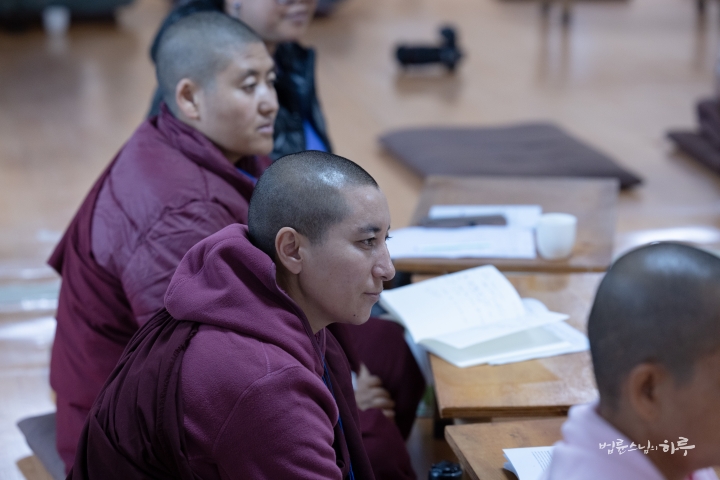
As the conversation continued, it was time for lunch. The female INEB participants had their meal in the Dharma hall, while Sunim had a lunch appointment with guests and moved to the practice room to wait for them.
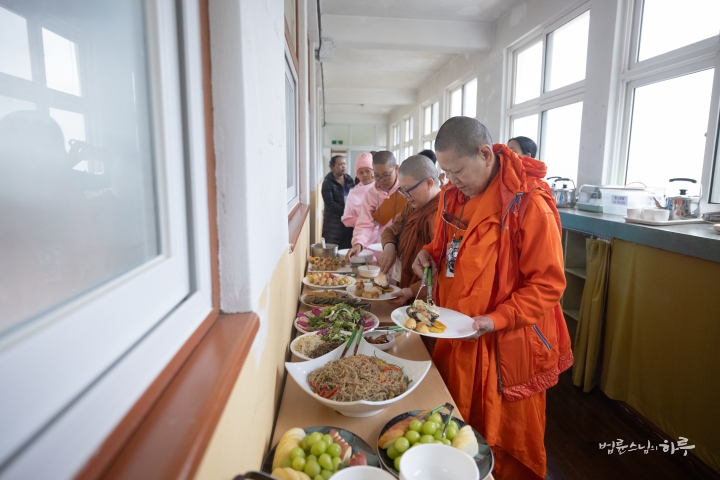
Many volunteers worked behind the scenes to prepare for this Women’s INEB Jungto Society Study Tour program. At Dubuk Jungto Retreat Center, the Gyeongju branch prepared meals, at Seoul Jungto Social and Cultural Center, the facility management team helped, and at Mungyeong Jungto Retreat Center, members from the Daejeon-Chungcheong branch prepared the meals. Sunim expressed gratitude to the volunteers and took a commemorative photo with them before the guests arrived.
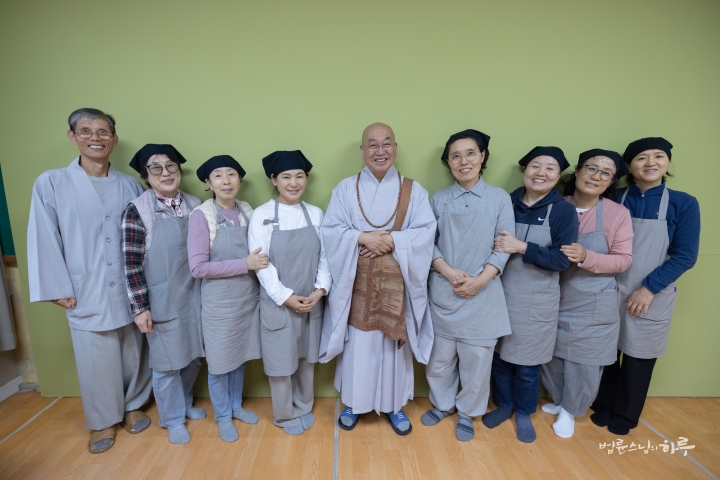
At noon, representatives from the Misowon Foundation visited Dubuk Jungto Retreat Center to deliver a donation to JTS. The Misowon Foundation (Chairperson Jang Yu-jeong) has been donating funds for tuberculosis patient medical support and well-digging projects to JTS India for 23 consecutive years. They brought their collected donation again this year. First, they shared lunch together and caught up on recent news.
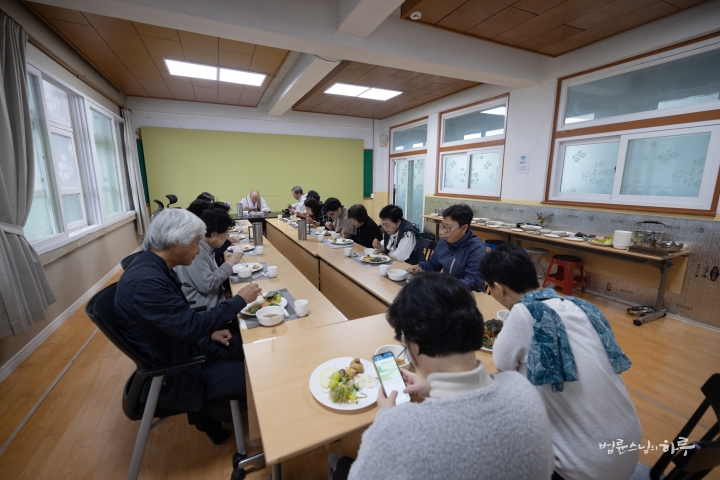
After the meal, the donation was presented.
“Thank you.”
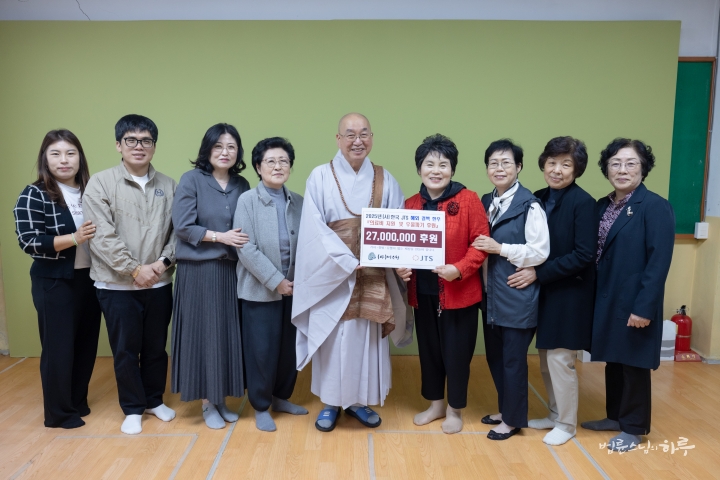
After taking a commemorative photo, they engaged in various conversations. Sunim asked Dharma Teacher Bogwang, the director of JTS India, and Dharma Teacher Hyanghoon, the director of JTS Philippines, to say a few words. As field directors responsible for using the donations, both of them personally expressed their gratitude to the Misowon donors.
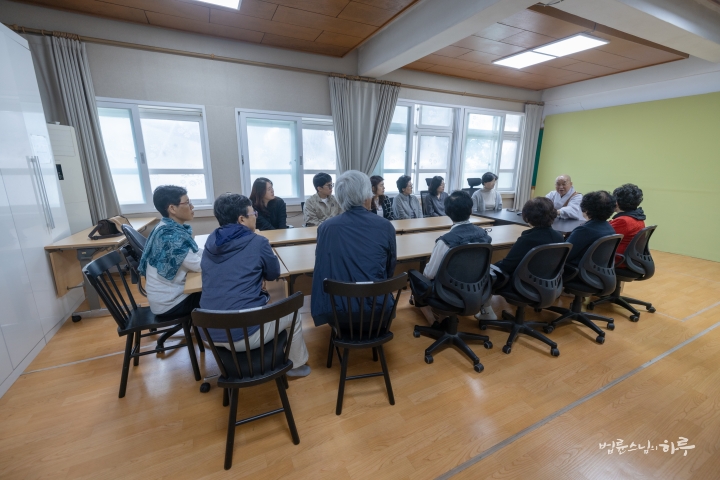
First, Dharma Teacher Bogwang expressed his gratitude.

“In the village of Dungeshwari, India, illiteracy has now almost disappeared. At the hospital, the number of tuberculosis patients, which initially reached 500, has now decreased to about 8-9 people, and food support continues steadily. Since last year, we’ve also started a ‘Build a House’ project for the most vulnerable neighbors without homes. From our experience, building one house costs about 2.5 lakh, approximately 5 million won in Korean currency. JTS provides the materials, and village residents participate directly in the labor, building houses together. The fact that these projects have continued for so many years without government support is thanks to the consistent love and dedication of donors like you.”
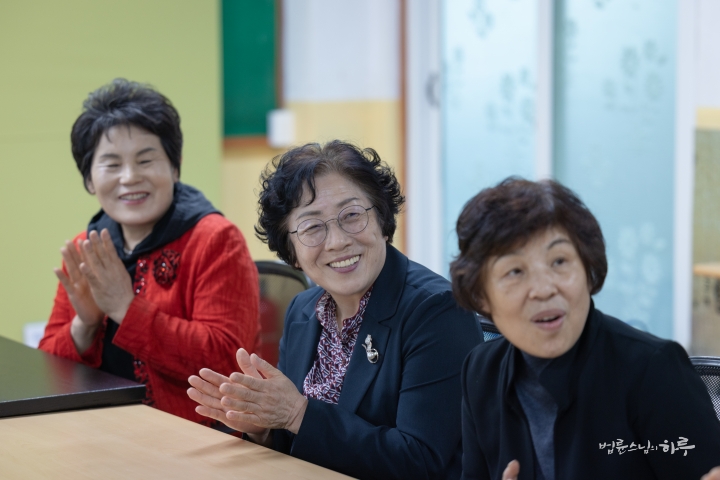
Next, Dharma Teacher Hyanghoon expressed his gratitude.
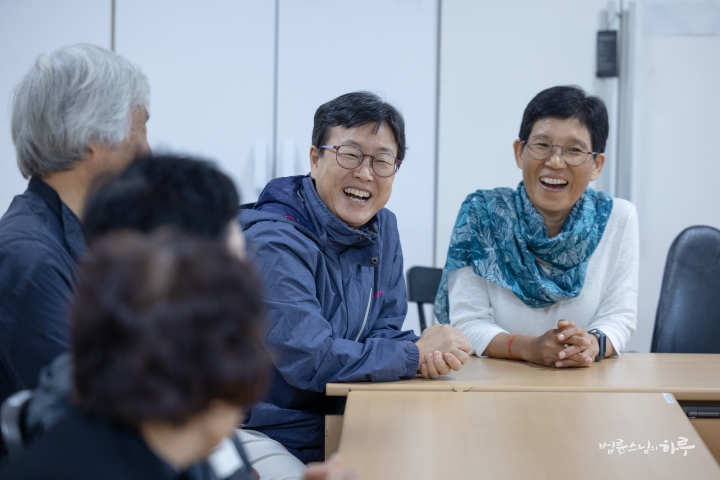
“In Mindanao, Philippines, we have built a total of 72 schools and 206 classrooms so far, and we are building 15 new schools this year. Most are located deep in the mountains, requiring at least an hour’s climb to reach the school sites. It’s difficult enough to walk empty-handed, but villagers carry plywood sheets and steel bars on their heads to transport materials. Despite this, we supply materials weekly, monitor the construction process, and cooperate with local government offices. Thanks to all of you, the projects are progressing well. If you have the opportunity, please visit JTS Philippines.”
Sunim also introduced that many schools for children with disabilities are being built in Mindanao, Philippines.
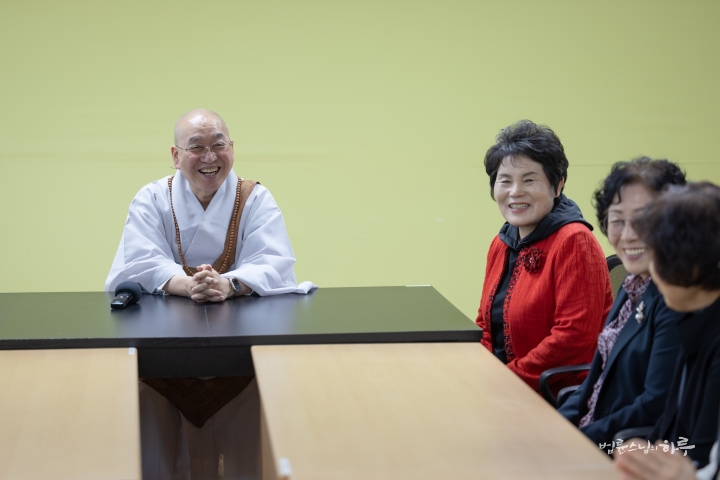
“In the past, even when we conducted surveys and built schools ourselves, the Philippine government often didn’t dispatch teachers. So we had no choice but to appoint village youth as teachers to teach the children. However, recently the Philippine government has begun to show interest in basic education. The problem is that the budget doesn’t follow. As the number of children attending school has increased but classrooms are severely lacking, they have no choice but to divide classes into morning and afternoon sessions, running two or three shifts. According to mayors and education officials, the situation is like this:
‘It’s not that we don’t want to educate students with disabilities. However, when general classrooms with 30-40 students are already lacking space, and special education classrooms only have 5-6 students, with the same budget, we have no choice but to prioritize general classrooms.’
In other words, it’s not a lack of will but a lack of funding. Understanding this, we decided that JTS would cover the budget for classrooms for children with disabilities. As a result, the special school construction project is actively progressing in the Philippines.”
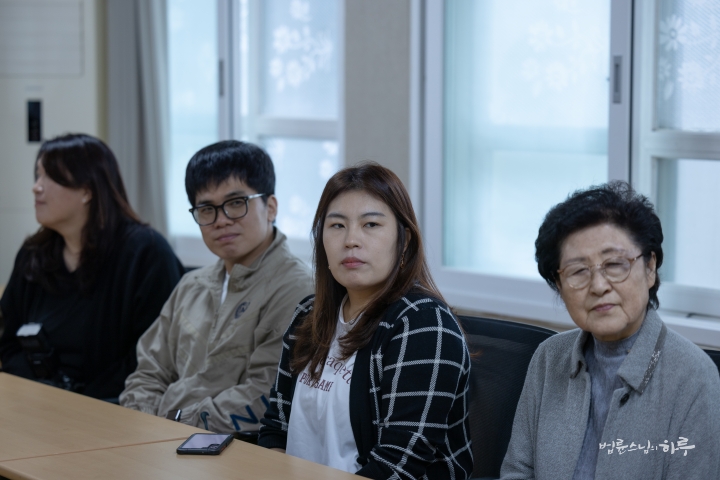
After finishing the conversation and seeing off the Miso Center members, Sunim had another dialogue session with female INEB participants starting at 1:30 PM. In the afternoon session, someone who is actually running the ‘Happiness School with Venerable Pomnyun Sunim’ came and gave a detailed introduction to the Happiness School program.
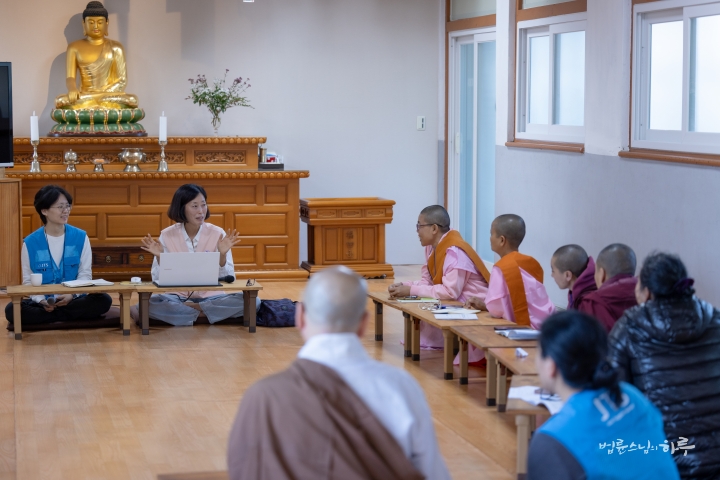
After a Q&A session about questions regarding the Happiness School, Sunim made a final suggestion.
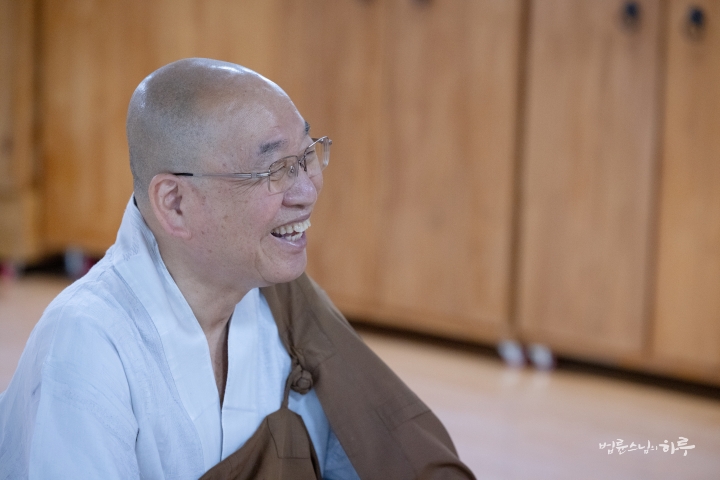
“Since you’ve come all the way to Gyeongju, how about visiting Bulguksa Temple this afternoon? It’s a UNESCO World Heritage site and the most famous temple in Korea. It’s such a globally visited place that it’s even included in the official itinerary of the APEC summit being held in Gyeongju. I suggest adjusting the program to make a brief visit there.”
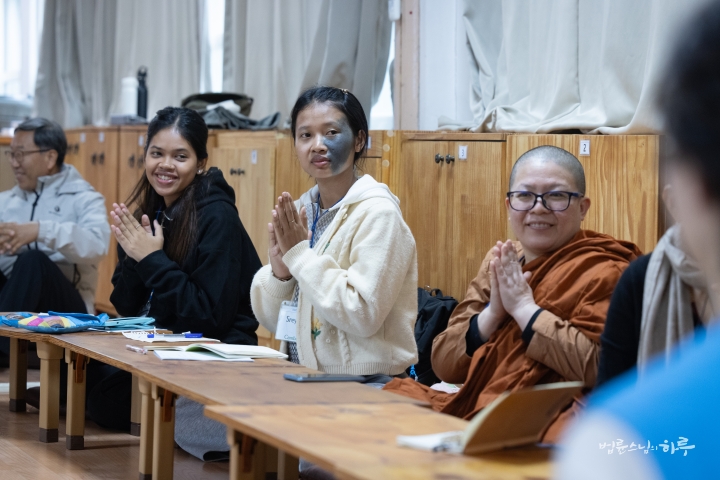
Following Sunim’s suggestion, the program was changed and everyone headed to Bulguksa Temple.
“Have a good visit.”
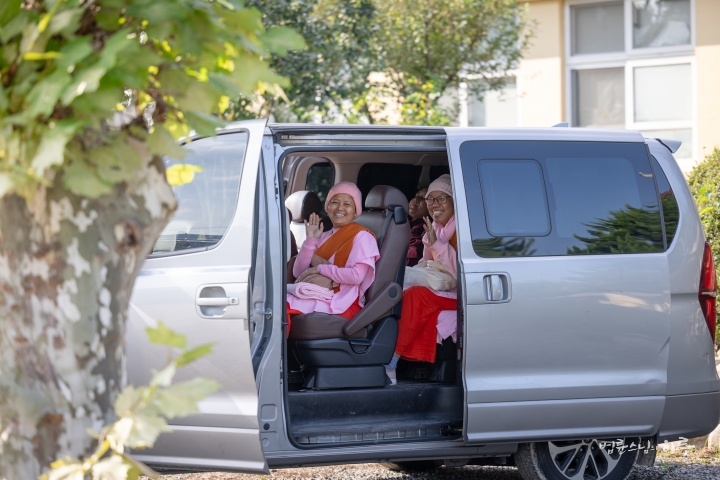
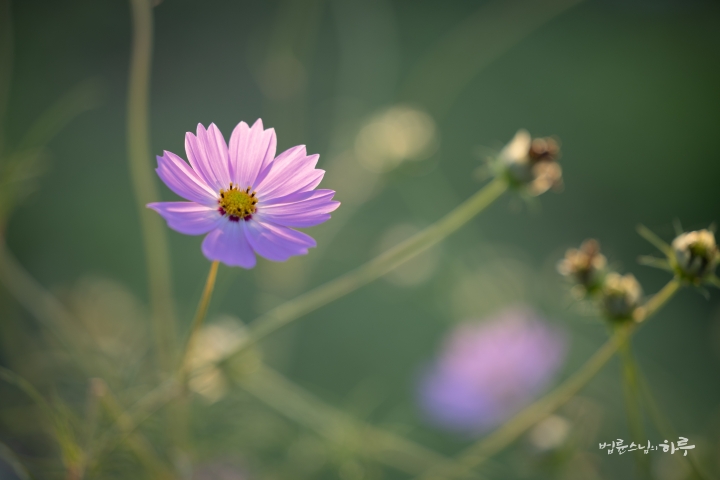
While the female INEB participants spent the afternoon on a pilgrimage to Bulguksa Temple, Sunim spent time with Dharma Teacher Bogwang and Dharma Teacher Hyanghun, who were visiting Korea after a long time. They shared updates on the current status of JTS India and JTS Philippines projects and had dinner together.
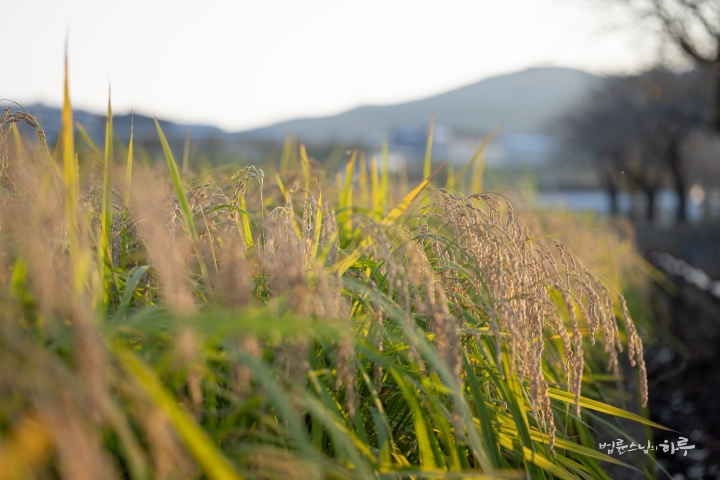
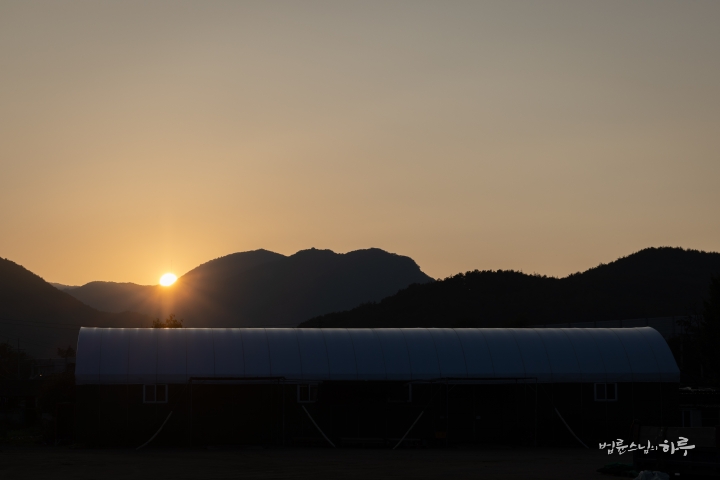
As the sun set, the female INEB participants also returned to Dubuk Jungto Retreat Center after completing their pilgrimage to Bulguksa Temple. After conducting evening prayers in the Theravada style at 6:30 PM, they continued their dialogue session with Sunim.
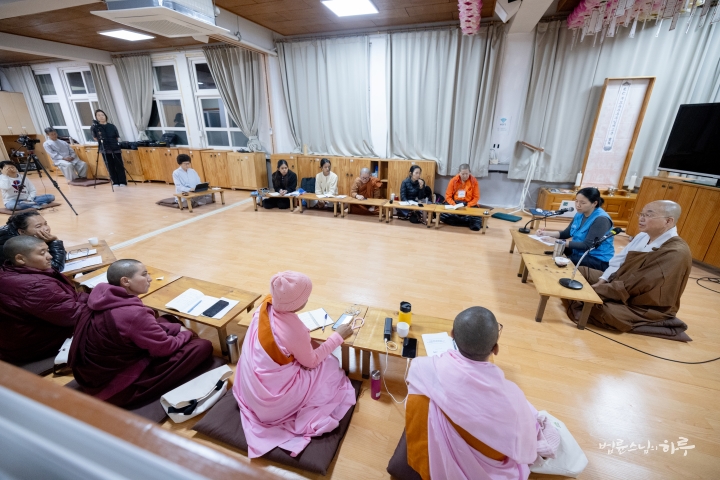
“Did you enjoy your visit to Bulguksa Temple?”
“YES!”
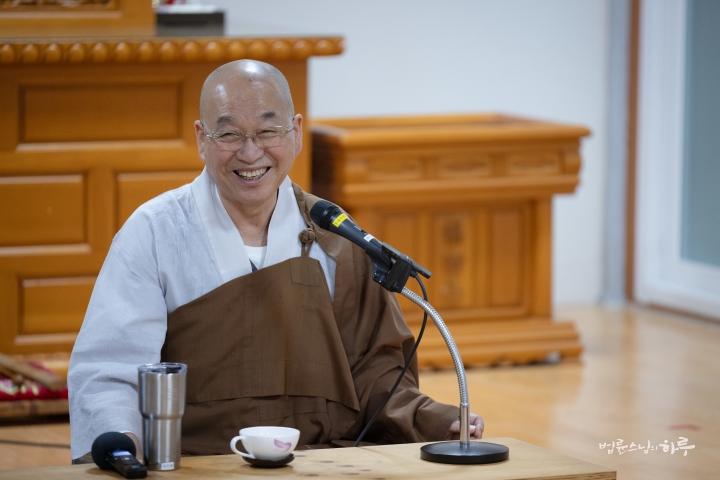
“It’s much better to go out and see things than just sitting in a room, isn’t it?”
“It was nice because there were so many trees.”
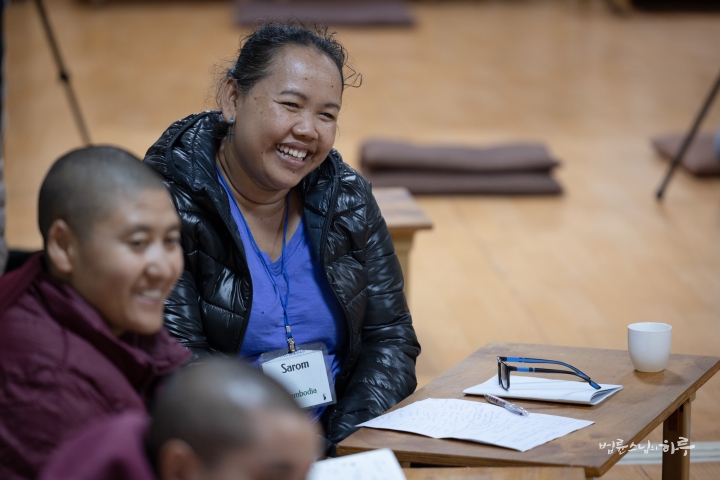
Anyone who had questions then asked Sunim. As they entered the fifth day of the study tour, having seen and heard so much, the questions multiplied. Fourteen questions arose during the two-hour session. One of them was about practice. When the mind becomes scattered and awareness disappears, they sought Sunim’s advice on how to regain focus.
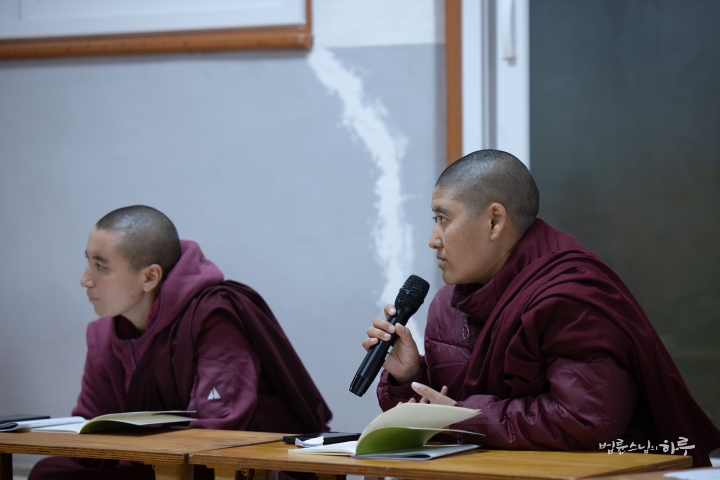
When My Mind Wavers, How Can I Return to an Aware State?
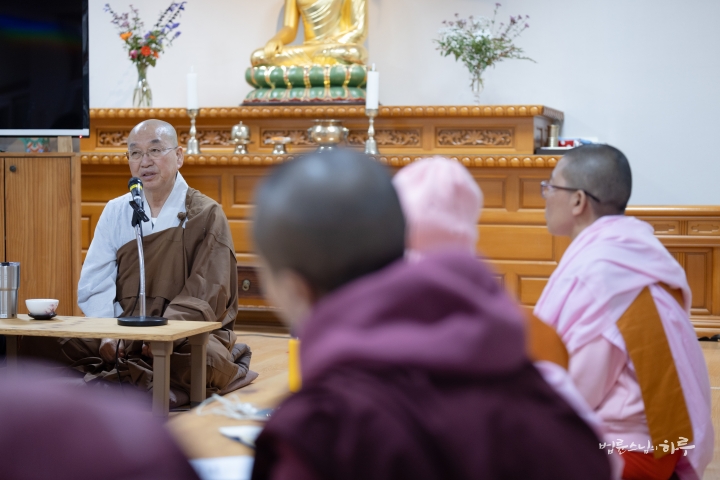
“The most important thing is to notice that state. If you’re angry, notice ‘I’m angry.’ If your concentration is scattered, notice ‘My concentration is scattered.’ In other words, it’s important to notice your current state as it is. Rather than thinking about what state you should be in, noticing the state of this very moment is ‘being aware.’ You don’t need to forcefully change your mental state or do something special. Just notice as it is – ‘I’m angry,’ ‘I’m anxious.’
Meditation is not about having specific thoughts but about a state without thoughts – a state of stopping. When we say ‘notice the breath’ in Buddhist meditation, it means we’re not thinking various thoughts but simply noticing that we are breathing, just as it is.
Our thoughts don’t stop. It’s natural for thoughts to arise, but we shouldn’t attach meaning to those thoughts. Even thinking about the Buddha or recalling the Buddha’s teachings during meditation is just delusion, not meditation. When thoughts stop, the mind naturally becomes calm.”
Questions continued to flow.
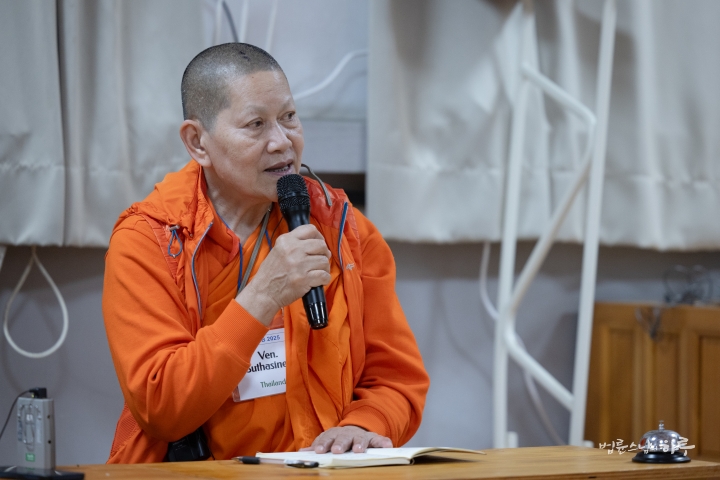
What is happiness? If everyone’s happiness is different, how does Buddhism define happiness?
What is the fundamental cause of suffering in our lives? Where are the roots of greed and attachment?
What do you do when you feel bored or idle? How do you spend such time?
When emotions arise while listening to people’s questions or stories, how do you manage them? How can we avoid being hurt by criticism or expectations?
What do you think the future of humanity will be like?
How can people see each other as one rather than as separate beings?
How can I know if I’m meditating well?
The age of Jungto Society Dharma Teachers tends to be high. How do you plan to overcome generational differences and cultivate young leaders?
Cambodian monks are fundraising to support war. Does this action align with the Buddha’s teachings? How should we balance national protection with Buddhist teachings?
Is there a way to experience the ‘Awakening Retreat’ without directly participating? How could that help my practice?
What is a good daily practice routine for beginners? What was your daily practice like when you were young, and what is it like now?
As the dialogue deepened, a question about Myanmar’s civil war situation also arose. They sought Sunim’s advice on how he would act if he were a monk in Myanmar and what path could lead to peace.
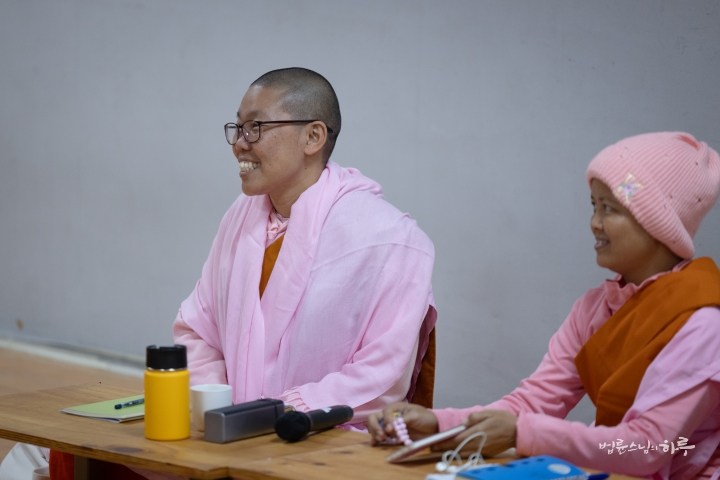
If You Were a Monk in Myanmar, What Choice Would You Make for Peace?
“Since I am not a monk in Myanmar, that question is not appropriate for me.”
“Then, could you tell us the path for Myanmar to move toward peace?”
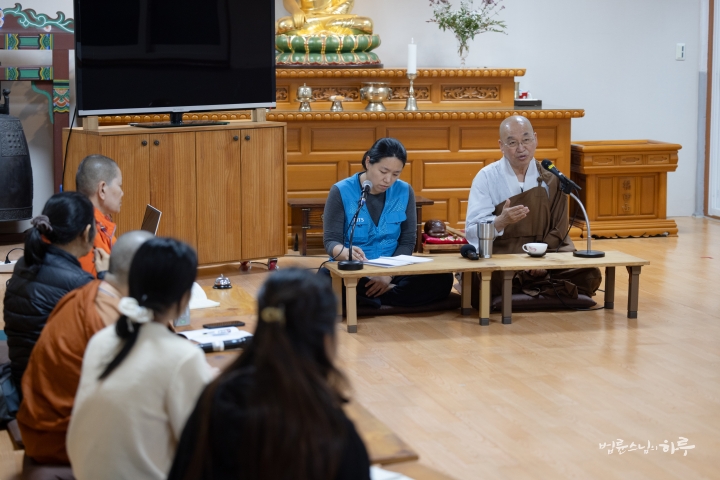
“We must base it on the Buddha’s teachings. We can see by looking at how the Buddha acted in his time. There are two stories related to peace.”
The first story is about when two tribes were fighting to claim water for themselves. The Buddha did not turn away from the situation, but he also did not try to solve the problem through force. Instead, he enlightened them about how foolish their fighting was.
The Buddha asked them, ‘Which is more precious, water or blood?’ They answered, ‘Of course blood is more precious. How can we compare water to blood?’ Then the Buddha said, ‘Then why are you trying to shed blood to obtain water?’ Hearing this, the people realized their foolishness and stopped fighting.
The second story is when the king of Kosala tried to invade Kapilavastu, the Buddha’s homeland of the Sakya clan. The Buddha did not turn away from this event but sat meditating under the scorching sun by the roadside where the king would pass. In India at that time, there was a custom of dismounting from one’s horse to pay respects when meeting a practitioner on the road. When the king saw the Buddha, he asked, ‘Why are you meditating under this scorching sun when there are nice shady places under trees?’ The Buddha replied, ‘Your Majesty, there is no better shade than the shade of one’s kinsmen.’
Hearing this, the king stopped his invasion and returned, but he could not suppress his resentment toward the Sakya clan. The next day, when he led his army out to invade again, the Buddha sat meditating in the same place. The same dialogue ensued, and the king withdrew again. But that night, the king resolved, ‘Tomorrow, even if the Buddha is there, I will just pass by.’ The next day when the king passed by again, the Buddha was not in that place, and ultimately the Sakya clan was destroyed.
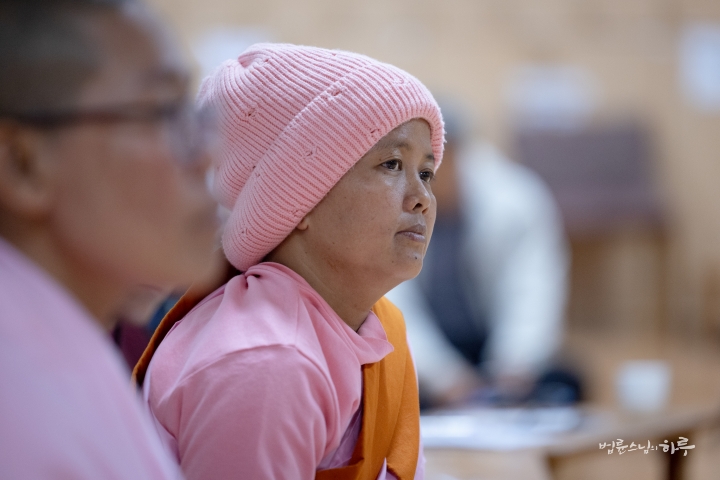
The Buddha did his utmost for those who could attain enlightenment, but when others tried to solve problems through violence, he never responded with force. We too must not turn away from reality, but always do our best through peaceful means. If there is a danger of war, we must work to prevent it. If war has already broken out, we must strive to stop it and care for the victims of war. After the war ends, we must work on recovery and healing. We must do our best in this way, but accept whatever results come and move forward to the next step.
The monks of Myanmar should at least not support or condone the military’s violence. That goes against the Buddha’s teachings. While they may sometimes resist unjust violence, there is no teaching from the Buddha that says to resist, so it is not something to be recommended.
In Korean history as well, during foreign invasions, especially during the Japanese colonial period, many monks and Buddhists resisted. Regardless of whether their choice was right or wrong, that is what they did. Bulguksa Temple, which you visited, was also mostly burned down by the Japanese army about 400 years ago. The reason was that the monks at that time took up arms and resisted.”
Finally, there was also a question about the impact of artificial intelligence (AI) development on Buddhism and practice. Someone asked about Sunim’s thoughts on how Jungto Society plans to connect with the younger generation and transmit the Dharma in the AI era.
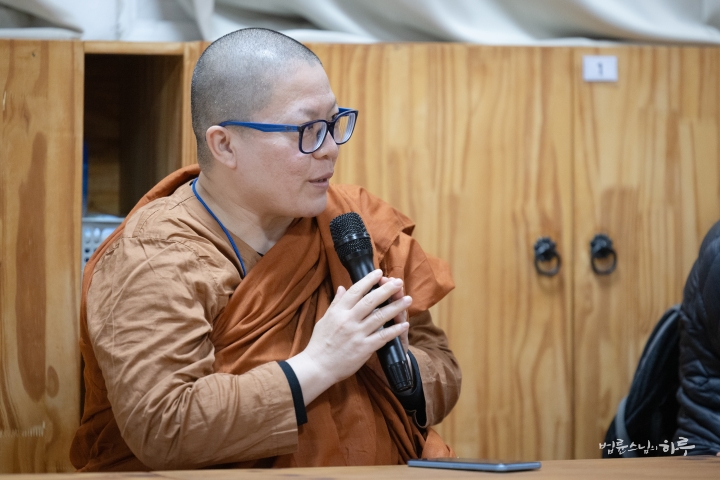
How Can the Buddha’s Teachings Be Transmitted in the AI Era?
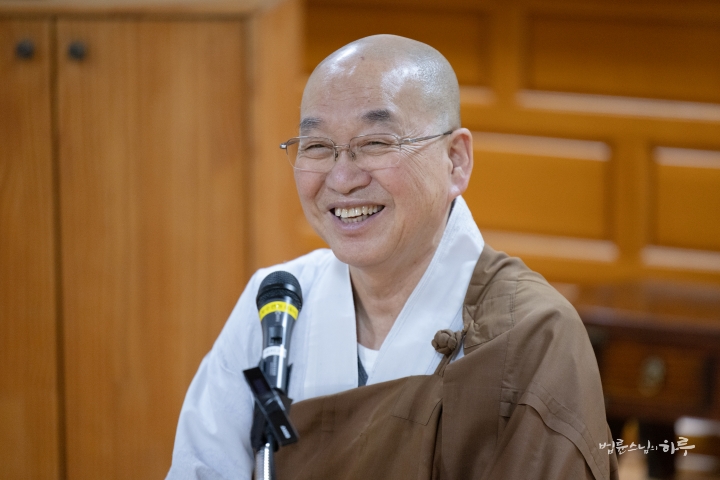
“Looking back at history, the emergence of artificial intelligence is not that special. The Buddha’s teachings were initially transmitted through direct meetings and conversations between people. However, when the Dharma was only transmitted orally, there were limitations to its spread. Between about 500 to 1000 years after the Buddha’s parinirvana, when the Dharma was compiled in written form, it could be transmitted to distant regions like China and Korea without having to go there directly. The teachings could also be passed down to future generations hundreds of years later.
While being able to spread the Buddha Dharma widely through written text was a great advantage, it also created side effects. When people converse, personality is transmitted along with the message, but written text has less of that power. As a result, when people read and understand the Buddha Dharma through books, practice tends to remain at the level of knowledge, and Buddhism easily becomes conceptualized like philosophy or academic study. To overcome this problem, Seon Buddhism emerged with ‘mind-to-mind transmission’ (以心傳心), transmitting from heart to heart.
Today’s YouTube and artificial intelligence are also very useful for spreading the Buddha Dharma widely, but we cannot completely avoid side effects. What’s important is how well we utilize AI’s usefulness and how we minimize its side effects.”
“Then, what should be done specifically?”
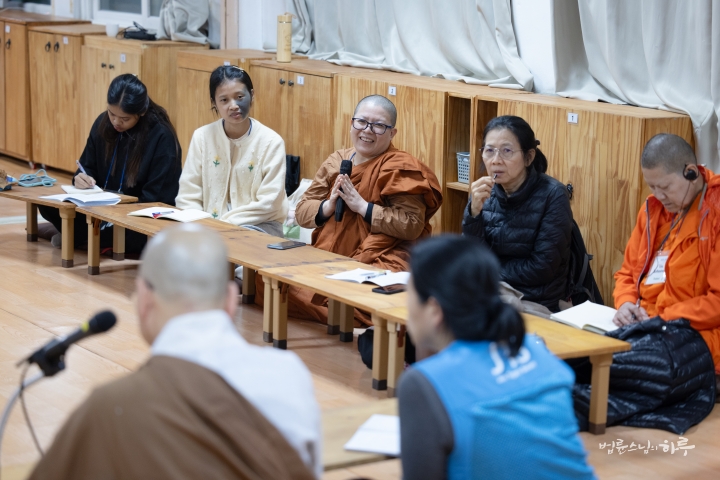
“Jungto Society is already actively using YouTube, but we haven’t yet actively utilized artificial intelligence. Reviews will be conducted depending on how much AI becomes part of daily life and how universal it becomes in the future. For example, there was a proposal to create a ‘Venerable Pomnyun Avatar App’ by training AI with about 10,000 Dharma Q&A materials. It would be a system where people could get immediate answers by asking questions to the avatar when they have difficulties, without having to come see me directly. Of course, that would be very useful. However, the reason I haven’t allowed it yet is because there’s a risk of the Dharma becoming fixed. The Dharma is the teaching of the Middle Way that must change according to situations and conditions, but AI tends to create rules like ‘in this case, do this; in that case, do that,’ which can deviate from the essence of the Dharma. So such matters must be decided carefully while observing the flow of social change. However, because Jungto Society introduced podcasts and YouTube much earlier than other organizations, we were able to secure many subscribers and spread the Buddha’s teachings widely as we do now. Thanks to that, it was also much easier for Jungto Society to transition online.”
How Does Jungto Society Draw Out the Capabilities of the Younger Generation?
“I don’t think the younger generation is particularly different when it comes to transmitting the Buddha’s teachings that lead toward nirvana.”
“The Dharma teachers at Jungto Society seem to be somewhat older. In that regard, isn’t there a generation gap? If so, how do you plan to overcome that problem?”
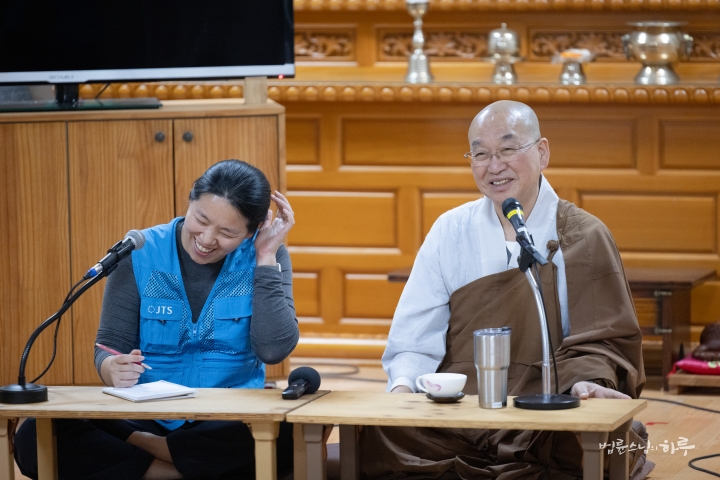
“Jungto Society has also focused on spreading the Dharma to young people. As a result, the proportion of young people among Jungto Dharma School students has increased from 10 percent in the past to about 20 percent currently. Of course, due to the nature of practice, it’s not easy for young people to become Dharma teachers quickly. So as part of spreading the Dharma to youth, we plan to hold a ‘Youth Festa’ next month at the Jungto Social and Cultural Center, a 3-day, 2-night event with 10,000 young participants. We want to make it easier for young people to access the Buddha’s teachings beyond religious barriers.
Jungto Society has a higher proportion of young people compared to other temples or religions. This is because we mainly use online platforms, making it easy for young people to access, and we use general expressions instead of Buddhist terminology, focusing on practical content rather than formality. Also, Dharma Q&A deals with real-life concerns that arise in young people’s lives, making it easy to form connections.
However, cultivating young leaders remains a major challenge. Among the early members of Jungto Society, there were many who became monastics, but nowadays fewer young people are joining the community as monastics. As a result, difficulties are arising in developing leaders for the long term. Currently, compared to the overall trend in society, Jungto Society still has a relatively high rate of young people participating as members. However, in the long term, for the younger generation to become leaders, they need to become monastics and live in community, but in Korean society, the number of people becoming monastics is significantly decreasing. These days, many families don’t have children or raise only one child, so there’s also a social atmosphere where it’s difficult for parents to accept their children becoming monastics. Due to these social phenomena, Jungto Society is also being affected.”
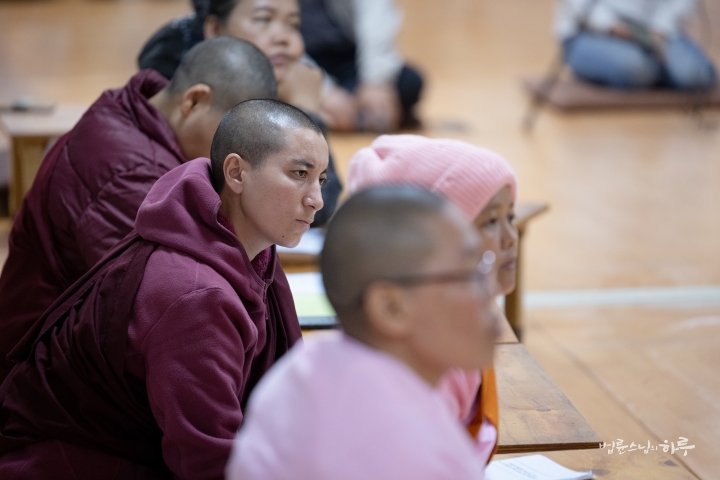
There were many more questions they wanted to ask, but the conversation had to come to an end here.
Since they might not be able to meet Sunim again due to scheduling constraints, everyone took a commemorative photo together. During today’s Happiness School introduction, they had learned some Korean phrases. When taking the photo, they tried speaking Korean.
“Gwaenchana!” (It’s okay!)
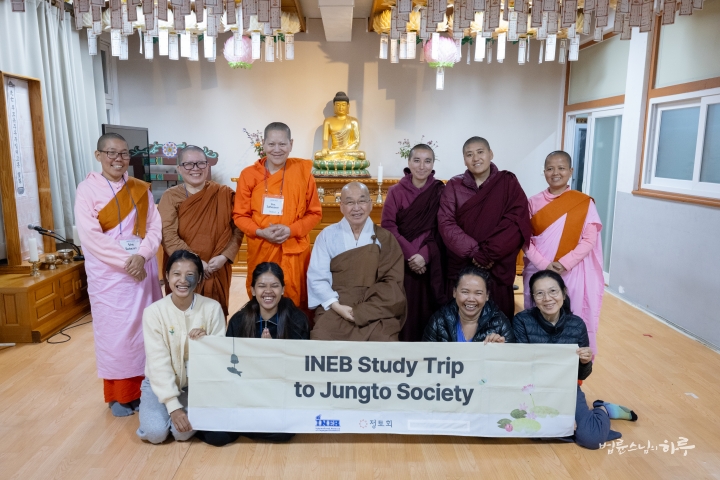
When they heard that this might be their last meeting with Sunim, several people’s eyes welled up with tears. They repeatedly bowed with palms together, expressing gratitude for the opportunity to learn so much.
“When you visit Silsangsa Temple tomorrow, you’ll find beautiful scenery there too, and there will be much to learn. Please learn a lot before you return home.”
Sunim also bid farewell with palms together.
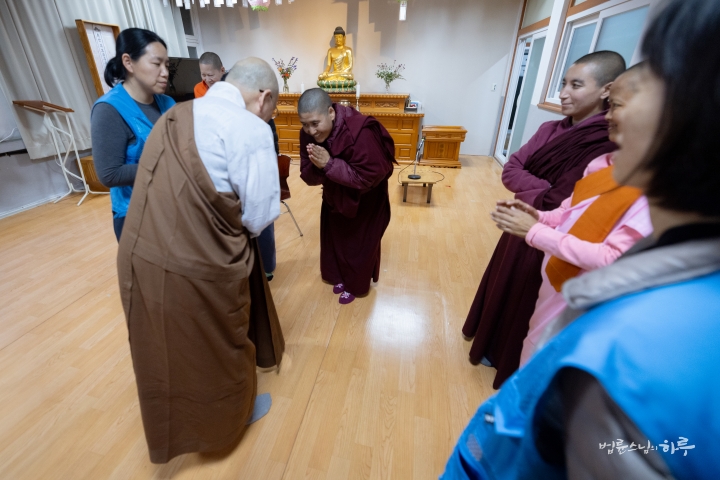
The female INEB participants gathered in their groups for a mindful sharing session before concluding today’s schedule.
Tomorrow is the day for the Dubuk senior citizens’ autumn outing. In the morning, Sunim will guide the seniors on a temple tour of Unmunsa Temple followed by a Dharma Q&A session. In the afternoon, they will move to Gyeongju for lunch, followed by a singing contest and entertainment time.





